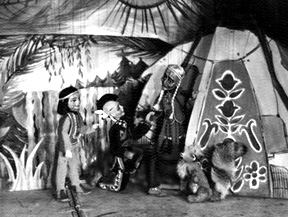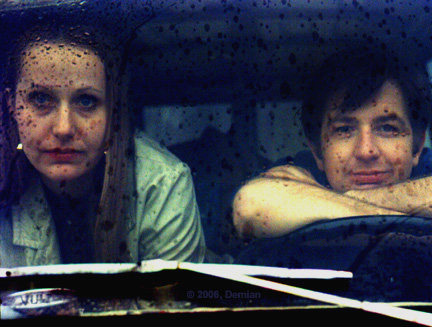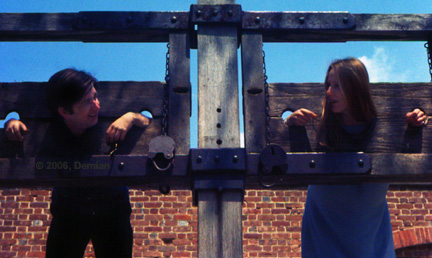
|
presentations that affirm self-esteem and social equality.
.
| MEDIA: Movies: Sweet Corn Vimeo YouTube Photos/Illos: Image Galleries Writings: Articles |
| SERVICES: Digital Production Image Retouch Puppets Script Doctor Shop |
| RESUMES: Directing Writing Visual Acting Web Programming About Sweet Corn About Demian |
| Puppet Projects |
|
The Marionette Tour - 1968 by Demian |
|
—— Nicolo Marionettes In April 1968, I joined the Nicolo Marionette Company for their Hiawatha tour, which played in New York, Massachusetts, Rhode Island, Connecticut, New Jersey, Pennsylvania, DC, and Virginia. I worked on the tour from April-to-June in 1968. Audience size ranged from 20-to-800. I performed in, at least, 79 hour-long performances. Nicolo Marionettes, which grew out of Suzari Marionettes, ran from 1962 to 1980. It had up to five simultaneous touring groups throughout much of the U.S. The company producer was Ruth Waxman, who set up the dates. The Hiawatha script was written by its artistic director Nick Coppola, and was based, very loosely, on “The Song of Hiawatha” by Henry Wadsworth Longfellow. Nick and Adam Kilgore collaborated on the script and made all the animal puppets, such as Adjidaumo the squirrel, the moose, bear, and birds. The authentic costumes were by Zona Atherton, and the colorful sets by Elizabeth Matta.
—— Three of a Kind For the Hiawatha tour, three of us hit the road: Olga Felgemacher, John Cunningham, and me. Occasionally, Suzie Kilgore would sub for Olga. We traveled via a very beat up old, panel truck. The back of the truck contained all the gear, which included the puppets, lights, sound system, and curtains in trunks, on top of which were placed the proscenium stage construction, puppet bridge assembly, and, above all of that, the flats. John did all the driving, Olga sat in the passenger seat, and I sat on top of the motor compartment. The long distance driving from show-to-show was exhausting. Fortunately, I was able fall asleep while we traveled, lying with my back on the flats, and my legs hanging over the front of the motor. John occasionally would need to shift gears, which he did by reaching for the clutch between my legs. I trusted John. However, I was uncomfortable with the prospect of the motor throwing a rod. The three of us played multiple characters in the show. The main ones I did were Hiawatha, and his father the West Wind. Olga played his grandmother, old Nokomis, Hiawatha’s friend, Chibiabos, and the dragon (a hand puppet). John played Hiawatha’s other friend, the squirrel, Adjidaumo, and the evil medicine man, Pau-Puk-Keewis.
I loved doing the show — working the figures, and doing the voices — however the schedule and traveling wore me out. Occasionally, the drive would run up to eight hours. It was a hard schedule, especially when the sponsors provided no assistance on arrival. —— Schools
It was very instructional to compare the various school cultures. There was a wide range of environments and social atmospheres. • The worst place was an elementary school in Hartford, Connecticut. With a playground of blacktop and no trees, the place looked more like a prison than any place you would want to leave your children. Poetically, the school was located on a street named “Asylum.”
No one greeted us when we arrived. No help setting up. The principal was nasty. We had a hard time hearing ourselves acting during the show as the audience never stopped talking. We refused the offer to eat in their lunch room as the three of us already had pounding headaches.
• The best place was an elementary school in Williamsburg, Virginia that had an amazingly polite student body. They were so attentive and quiet during the show that we kept taking peeks through the curtain to make sure they were still there. At the end of the show, there was a warm applause. It was so quiet in the cafeteria we could hear the opening of wax paper bags. The orderliness and courteous atmosphere was amazing because, unlike most of the schools that were noisy, this one had no hall monitors. This all-black school had a genuinely peaceful culture.
• In Otisville, New York, the kids had nicknames for all their teachers. The ones they told to me included “Mussolini,” “Stone Face,” “Frog,” and “Blue Balls.” —— Show Effects
• One of the best effects of the show was during Hiawatha’s prayer to his father, the West Wind. At that point, I get into a costume and face mask and crawl on the stage for a conversation with Hiawatha. By this time the audience has adjusted to the smaller, puppet’s perspective and the appearance of the larger figure was startling. At one show, one of the shocked audience members whispered loudly: “It’s a giant!” • The evil Pau-Puk-Keewis realizes he is not able to destroy Hiawatha, so he calls on magic for greater power. He starts a dance and takes leaps in the air. As he jumps, his war cries begin to sound more like a hawk’s. His leaping brings him behind the curtain. He leaps back into view. After leaping off a third time, when he leaps back he startles audiences by his complete transformation into a vicious bird of prey. —— A Funny Thing (or two) Happened on the Way • On Long Island, we did a show where everything went badly. There was no help to set up, and we even had to clear off the stage before we could bring in our gear. I could not concentrate and dropped lines. John and Olga seemed to have similar problems, and we all had puppet strings tangle. In the middle of the show, the stage tree fell over.
The show finally over, we packed gear to load the truck, and then had to push the truck in the rain to pop the clutch. John had left the headlights on and battery had died. • During long breaks between shows on the road, I would occasionally entertain by hypnotizing John and Olga. As they were intelligent, they were easy to hypnotize.
The more interesting results, though, came from Olga, as she saw John as his character, Adjidaumo, only, instead of being a small squirrel, he was as large as John’s real size. Also, she effortlessly saw herself as Little Miss Muffet, and we gleefully wiggled our fingers from on high, slowly lowering them toward her face.
• In Brooklyn, New York, we had a substitute for Olga who was having a call-back audition. Suzie (Rouse) Kilgore was married to Adam Kilgore, who makes puppets and does his own shows. She did very well with great energy and vocal finesse, however, occasionally her lines came out screwy. Instead of “Oh father, look at the bird on my loom,” we once heard “Oh father, look at the bird on my womb.” I could never tell if the word substitutions were deliberate or not.
• Sometimes we invited the older kids to see the show from backstage. In the same Brooklyn show that Suzie subbed, there was a small crowd in the wings watching us work. John was on the puppet bridge, with the bird of prey puppet, which takes two hands to operate. I noticed his character was not as masterfully controlled as usual. Something was wrong. John tried to keep the show going, but could not stop laughing. It was then I noticed that he could not simultaneously hold the puppet and reach his pants with the broken zipper which had fallen to his ankles. • In North Adams, Massachusetts, we went on a four-seat airplane for a tour of the gorgeous mountains. John and Olga, apparently nervous about bouncing around in a small plane, sat in back, while I sat in front next to the pilot, Bill Stein. Flying looked easy. To my mind — airplane control, puppet control — its all the same. So I asked Bill if I could try it. He gave me a few instructions while Olga said, “This is not a good idea,” and John hoarsely whispered, “Oh, sweet Jesus.” Bill gave the plane’s steering control to me. Just then, we hit some turbulence and the plane bounced. John screamed louder than Olga. Another bounce confirmed to the back seaters that we were doomed.
Bill complimented my piloting, saying I handled the windy gusts well, as I relinquished the controls back to him. He invited us to a party he and his wife Bonnie were having that evening. John and Olga were happy to be back on the ground and navigating city streets and turnpikes, which they presumed to be safer than flying. • Suzie subbed for one of the shows we played on Long Island, New York. On this particular show, someone tripped on the wire to the sound system, cutting off our show’s background music. That same day, Suzie and I ad-libbed, stalling for time, once again, while John frantically worked to undue one of that day’s many terrible puppet string tangles. As Hiawatha, I asked of her character the bear: “Mishe-Mokwa, do you know of any short cuts to the village?” Smothered in the bear head mask, Suzie replied: “Why yes, you just head east of the sun, and — oh, what was that now? — oh yes, west of the moon.”
What was there to discuss? Did I step on one of her lines, or, in the darkness on the puppet bridge, her foot? There came a knock. Both Olga and John appeared, disguised, with burnt cork all over their faces. They wore head scarves and brandished cleaning rags, racing through my room — completely ignoring me — not cleaning, but throwing things about. All the while they kept a steady stream of vaudeville dialect insults running: “My, my, my, this place sure is a mess,” “Just look at this dirt!” and “This boy has no shame.”
Never once acknowledging my presence, they had completely trashed my room, quickly ran out, and left me flabbergasted. • During one show in Queens, New York, there was pandemonium in response to the evil medicine man, Pau-Puk-Keewis, in the guise of a dragon, threatening to devour the squirrel. After yet another narrow escape of the dragon’s jaws, there was a moment of total silence. Then a distraught child yelled out, “Watch out for KA-KA-PEE-wiss!” John couldn’t stop laughing and his squirrel just hung there shaking. Where They Are Now? Nick Coppola Nick wrote to me on January 10, 2006: “I look back on those days and wonder how on earth we did them and survived. The reason I’m still going, is probably because I stopped the touring in the late 80s, and concentrated on developing our own theater in Brooklyn.”
In 1980, Nick created Puppetworks, a non-profit, for which he is the artistic director. He produces shows, workshops, and demonstrations. John Cunningham
Nick told me that John became an Equity stage manager, and that he died some years past. Olga Felgemacher Olga wrote on February 11, 2006, that she remembers a lot of canned soups connected to the touring days. A particular brand of which, to this day, she will not touch. Olga, along with her husband Craig Marin, continues in puppetry in New York City. In 1979, they formed Flexitoon. Soon after creating Flexitoon, they were joined by Mike Campbell. Flexitoon created the Ace Award winner “Pinwheel” for Nickelodeon. They turned the Weekly Reader characters into dimensional stars with “KIDS-TV” on Showtime. Flexitoon created “DJ Kat” on Fox, which won the Outstanding Kid’s Show Award from the New York State Broadcasters Association. Flexitoon also helped develop and perform the popular Juke Box Band on the multi-awarded children’s series “Shining Time Station.” Flexitoon was awarded the first National Endowment for Children’s Educational Television Grant, and created and produced the special “Goin’ Up” for Thirteen/WNET. Flexitoon won the 1996 Henson Foundation/UNIMA Award for Outstanding Broadcast Puppetry.
Flexitoon also created a TV mini-series called The Hamptoons. This half-hour series takes place in a TV studio located underground. It stars Lucky Jack Rabbit, Quackerbox, and Sam Simian. |
|
Sweet Corn Productions || 206-935-1206 || demian@buddybuddy.com sweetcornmedia.com || Seattle, WA || Founded 1971 All contents © 2023, Demian, Sweet Corn Productions |


